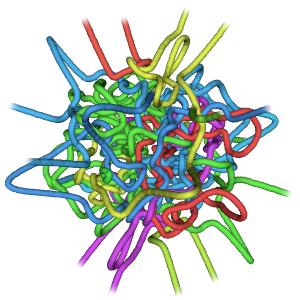Knots in chaotic waves

Tangled quantum vortices. Each vortex line is shaded in a different color, and may be knotted or linked with the others. Credit: School of Physics © University of Bristol
The computer experiments, by academics at the University of Bristol, give rise to a huge variety of different knots, realising many that have been tabulated by pure mathematicians working in the field of knot theory.
Waves surround us all the time: sound waves in the noise around us, light waves enabling us to see, and according to quantum mechanics, all matter has a wave nature. Most of these waves, however, do not resemble the regular train of waves at the shore of the ocean — the pattern is much more chaotic.
Most significantly, the whirls and eddies form lines in space called vortices. Along these lines, the wave intensity is zero, and natural wave fields – light, sound and quantum matter – are filled with a dense tangle of these null filaments.
Mark Dennis, Professor of Theoretical Physics in the School of Physics, said: “Although the computer models were framed in the language of quantum waves, these results are expected to be completely general, suggesting a new understanding of the complexity of the three-dimensional optical and acoustic landscapes that surround us every day.”
More than 40 years ago, Bristol physicians Professor Sir Michael Berry and Professor John Nye discovered vortices were originally understood to be a crucial part of wave phenomena.
This work is part of the Scientific Properties of Complex Knots (SPOCK) project, a collaboration between the Universities of Bristol and Durham. The aim of the project is to create new computational tools and mathematical techniques for the analysis, synthesis and exploitation of knotted structures in a wide range of complex physical phenomena.
The research, funded by the Leverhulme Trust, is published today in Nature Communications.
###
Paper:
'Vortex knots in tangled quantum eigenfunctions' by Alexander J Taylor and Mark R Dennis in Nature Communications
Media Contact
All latest news from the category: Physics and Astronomy
This area deals with the fundamental laws and building blocks of nature and how they interact, the properties and the behavior of matter, and research into space and time and their structures.
innovations-report provides in-depth reports and articles on subjects such as astrophysics, laser technologies, nuclear, quantum, particle and solid-state physics, nanotechnologies, planetary research and findings (Mars, Venus) and developments related to the Hubble Telescope.
Newest articles

A universal framework for spatial biology
SpatialData is a freely accessible tool to unify and integrate data from different omics technologies accounting for spatial information, which can provide holistic insights into health and disease. Biological processes…

How complex biological processes arise
A $20 million grant from the U.S. National Science Foundation (NSF) will support the establishment and operation of the National Synthesis Center for Emergence in the Molecular and Cellular Sciences (NCEMS) at…

Airborne single-photon lidar system achieves high-resolution 3D imaging
Compact, low-power system opens doors for photon-efficient drone and satellite-based environmental monitoring and mapping. Researchers have developed a compact and lightweight single-photon airborne lidar system that can acquire high-resolution 3D…





















